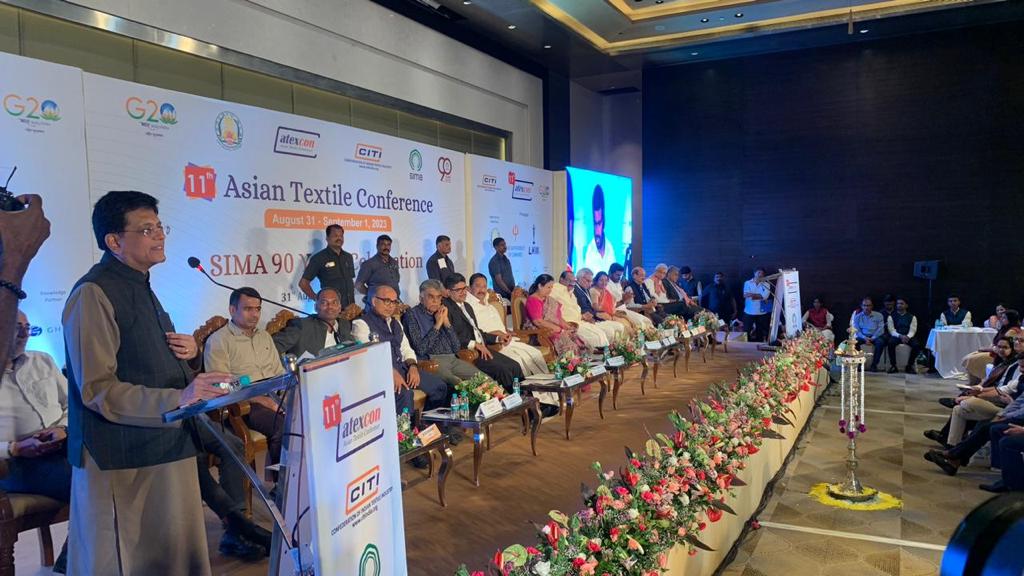
Category: General
Country: India
Region: Asia Pacific
By Nivedita Mukherjee
September 2, 2023
New Delhi: The Government is looking at India’s potential to become the world’s largest textile hub by developing indigenous technology and textile machines for the Indian textile Industry, reducing dependency on imports and at the free trade agreements to enhance the presence of India’s textile sector globally. The much awaited conclusion of FTA with the UK is expected to boost the textile industry. “We must scale up the indigenous textile technologies and modern machines through R&D and innovation.
It is a matter of pride for Tamil Nadu, Coimbatore and India,” Commerce and Industry Minister Public Distribution said at the 11th edition of a global congregation of leading players of the Asian textile industry, input suppliers and service providers —ATEXCON in Coimbatore which has drawn attention to key areas of business, including regional as well as global issues concerning this sector.
The initiative by the Confederation of Indian Textile Industry (CITI) brought together the entire textile value chain to discuss the issues and roadmap of the Indian textile industry which has achieved significant leap in exports culminating in delivery of about 776 billion worth of textile goods around the world during 2022-23. This is an increase of about 55 per cent in a span of just two years. What has also emerged from ATEXCON deliberations is that the Indian textile industry is primarily concentrating on the supply chain, made up of the 5Fs farm to fibre, fibre to factory, factory to fashion and fashion to foreign and has improved as a result of investments made in a number of departments, particularly research and development, which has enhanced the general performance of the fabrics used in the textile sector.
A report by Crisil projects profitability of home textiles makers to rebound this fiscal with revenue set to rise 7-9 per cent after a 15 per cent fall last fiscal, as India regains global share following a correction in domestic cotton prices and restocking by bigbox retailers in major markets abroad. After strong head- winds in exports last fiscal, the home textile industry is on the road to recovery. Domestic cotton prices, which had risen past international prices and reached Rs 1 lakh per candy1 in May 2022, have now retracted to Rs 55,000 helping India regain competitiveness. The report also points out that operating profitability will improve 150-200 basis points to 14.0-14.5 per cent, due to lower raw material cost and better operating leverage, but will still hover below pre-pandemic levels. Other positives are that credit profiles will continue to be stable, with the ongoing capital expenditure (capex) cycle in its last leg this fiscal, and healthy cash accrual driven by improved revenue growth and profitability.
The industry is in the midst of Rs 4,000 crore capex, planned to be completed between fiscals 2022 and 2024.
However, there are stiff challenges. The report, based on a CRISIL Ratings analysis of 40 companies, accounting for 40-45 per cent of the sector’s revenue, shows as much as 70-75 per cent of the industry’s revenue is from exports, with the US, its biggest market, accounting for more than half of it. On a hopeful takeaway, orders from big-box retailers in the US will increase this fiscal as the inventory piled up last fiscal depletes on easing global supply-sales recovery being seen over the past few months. “But capacity utilisation will improve only slowly because of the recent large capacity addition amid moderate demand growth. That will continue to keep operating margins below pre-pandemic levels,” says Makhija.
The textile industry has been flagging the stagnation in production and trade in the past few months and has sought adequate financial measures to provide relief to the industry.
“Textile industry is facing financial stress due to slow demand and price volatility of inputs in the recent past and Government is requested to come up with including a one-year moratorium for repayment of the principal amount and Converting three-year loans under ECLGS into six-year term loans,” says T Rajkumar, Chairman, CITI
As far as exports of cotton textiles is concerned, industry has amplified the need to ensure the supply of raw material and capacity building for better productivity and yield. “There are a set of projects approved by the Ministry of Textiles, Government of India to increase the production and quality of cotton in India. Industry is also pursuing the Government for TMC 2.0 and our emphasis is more on seed technology as improvised seeds will increase the income of the farmer,” says Sunil Patwari, Chairman, Texprocil.
The ATEXCON has highlighted policy imperatives such as technology upgradation for boosting productivity and efficiency. Another challenge is cluster development. India is built on clusters, which is the backbone of the industry. Public investments are required to be diverted to anonymous companies that contribute 90 per cent of the total industries in India while the remaining 10 percent of companies are registered and listed. Then there is policy distortion which calls for policies to be focused on unlocking the potential of Indian manufacturers and providing unhindered access to raw materials.
Courtesy: TheSundayGuardianlive.com
Copyrights © 2025 GLOBAL TEXTILE SOURCE. All rights reserved.